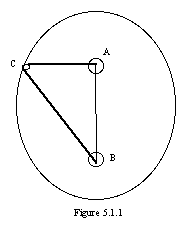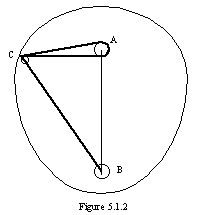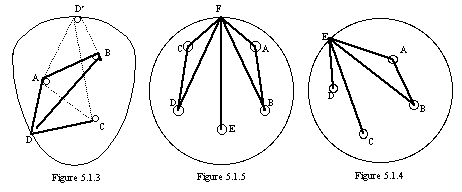James Clerk Maxwell - The Great Unknown
Kevin Johnson
Oval Curves
The importance of this paper was more the effect it had on Maxwell's life rather than its content. Although some of this paper was original, Descartes had already documented much of what was contained long before Maxwell began his work. However, the achievement was not that the ideas were new, but that they were conceived at only fourteen years of age. This paper helped put Maxwell in contact with some of his biggest influences and started him on the path to a career in mathematics.
 The inspiration of Maxwell's paper was the construction of a perfect oval ellipsis. This is achieved using a string attached by two foci A, B and is illustrated in figure 5.1.1. The oval is constructed by putting a pen at C and keeping the sum of the two threads AC and BC constant throughout.
The inspiration of Maxwell's paper was the construction of a perfect oval ellipsis. This is achieved using a string attached by two foci A, B and is illustrated in figure 5.1.1. The oval is constructed by putting a pen at C and keeping the sum of the two threads AC and BC constant throughout.
[Figures based on figures in Harman, 1990, p35-42]
 James expanded on these ideas by investigating several variants. The first was to double one of the threads, which produced an egg-shaped oval, as illustrated in figure 5.1.2.
James expanded on these ideas by investigating several variants. The first was to double one of the threads, which produced an egg-shaped oval, as illustrated in figure 5.1.2.
Maxwell measured these ovals by calculating the angle ABC when CAB was right angled. He observed that at most angles of ABC the focus B would be within the circumference (as in figure 5.1.2) but for lower angles it would be outside.
Having investigated cases of two foci, with the radii in proportion 1::2, Maxwell then went on to draw figures of proportion 1::3, 1::4, 2::3 and 3::4. He noted:
Maxwell discussed figures with three (figure 5.1.3), four (figure 5.1.4) and five (figure 5.1.5) foci where in each case the string must connect all foci to the point on the circumference. For instance in figure 5.1.3 the string goes C-D-A-B-D and in figure 5.1.4 it goes D-E-A-B-E-C. However, as illustrated in figure 5.1.3, when the string crosses a focus, the order in which the string passes through the focus must change in order to preserve all of the radii. Maxwell observed that when three foci are placed in a straight line they produce symmetrical figures. He also went on to make many other observations on these figures.

Maxwell's father having seen this work showed it to Professor James D Forbes of Edinburgh University. Forbes obviously thought highly of the work and wrote back saying:
Forbes agreed to read the paper to the Royal Society of Edinburgh and, following this, it was published in the society's transactions in April 1846. This began a friendship with Forbes that would last throughout his career and helped convince Maxwell's father that it was mathematics, not law that Maxwell should study.
 The inspiration of Maxwell's paper was the construction of a perfect oval ellipsis. This is achieved using a string attached by two foci A, B and is illustrated in figure 5.1.1. The oval is constructed by putting a pen at C and keeping the sum of the two threads AC and BC constant throughout.
The inspiration of Maxwell's paper was the construction of a perfect oval ellipsis. This is achieved using a string attached by two foci A, B and is illustrated in figure 5.1.1. The oval is constructed by putting a pen at C and keeping the sum of the two threads AC and BC constant throughout.
[Figures based on figures in Harman, 1990, p35-42]
 James expanded on these ideas by investigating several variants. The first was to double one of the threads, which produced an egg-shaped oval, as illustrated in figure 5.1.2.
James expanded on these ideas by investigating several variants. The first was to double one of the threads, which produced an egg-shaped oval, as illustrated in figure 5.1.2.
Maxwell measured these ovals by calculating the angle ABC when CAB was right angled. He observed that at most angles of ABC the focus B would be within the circumference (as in figure 5.1.2) but for lower angles it would be outside.
Having investigated cases of two foci, with the radii in proportion 1::2, Maxwell then went on to draw figures of proportion 1::3, 1::4, 2::3 and 3::4. He noted:
The greater the difference in the proportion such as 1 to 3 the figure of the Oval next to the preponderating focus approaches more nearly to the circle - and less the difference between the power of the foci as in the case the radii being as 3 to 4 - the form is kept more nearly to the ellipsis. [5, p37]
Maxwell discussed figures with three (figure 5.1.3), four (figure 5.1.4) and five (figure 5.1.5) foci where in each case the string must connect all foci to the point on the circumference. For instance in figure 5.1.3 the string goes C-D-A-B-D and in figure 5.1.4 it goes D-E-A-B-E-C. However, as illustrated in figure 5.1.3, when the string crosses a focus, the order in which the string passes through the focus must change in order to preserve all of the radii. Maxwell observed that when three foci are placed in a straight line they produce symmetrical figures. He also went on to make many other observations on these figures.

Maxwell's father having seen this work showed it to Professor James D Forbes of Edinburgh University. Forbes obviously thought highly of the work and wrote back saying:
I have looked over your son's paper carefully, and I think it is very ingenious, certainly very remarkable for his years; and I believe substantially new. [1, p75]
Forbes agreed to read the paper to the Royal Society of Edinburgh and, following this, it was published in the society's transactions in April 1846. This began a friendship with Forbes that would last throughout his career and helped convince Maxwell's father that it was mathematics, not law that Maxwell should study.